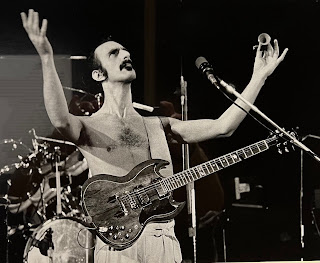FRONT ROW CENTER: ICONS OF ROCK, BLUES, AND SOUL
D’Amour Museum of Fine Arts, Springfield, MA
Through May 1, 2022
All of a sudden there has been renewed interest in photographic depictions of pop, rock, blues, and soul icons of the 1960s and 1970s. First came the online exhibit of works from the late Don Hunstein and now the D’Amour in Springfield is featuring images from Larry Hulst. It’s as if the Baby Boomer Magical Mystery Tour is mutating into the Baby Boomer Senior Citizen Bus Tour.
Hulst (b. 1946) might not pop instantly to mind, but you have probably seen his images on album covers or in Rolling Stone Magazine. He began shooting rock shows when he returned to the States in 1969, after serving a tour of duty in Vietnam. In his words, “I want to be where the action is. After all, the ‘show’ is projected out into the audience. I want to be in the audience.”
That last sentence is slightly disingenuous, as he usually worked on special commissions. This gave him access to performers that ticket-buying audience members did not have, but Hurst certainly knows a good shot when he sees it. There are more than 70 photos on display at the D’Amour that cover the period 1970-99. Many of the photos are accompanied by sound spots on which you can stand to hear music from the spotlighted musicians.
The l999 date is pretty much confined to shots of Lauryn Hill. In the sampling below I have concentrated on the 1970s into the 1980s. That’s the bulk of what is on display, plus I confess that my musical tastes shifted in the 1980s–from rock to Celtic and folk–because I couldn’t stomach hair bands, glam rock, or disco. I make no judgments about those styles; they simply weren’t my thing. If they are yours, you’ll feel represented by the D’Amour show, but here is my curated Magical Nostalgia Tour.
I’ll lead with my favorite shot. It’s of Bob Dylan. Or is it? Nope! It’s Joan Baez spoofing her old lover.
Here’s a shot of the actual guy alongside Tom Petty. It’s a good time to add a small note of criticism to the show. This one and others has reflections–I took out what I could–because many museums struggle with the lighting for photographs. That is sometimes the case for the D’Amour. Several of my favorite Hulst shots, including one of Grace Slick at a “Black and White” party dressed as a nun, had too much reflection to see them well. (Any shots in this article that are not crisp or as Hulst shot them are a combination of cropping, uneven lighting, and/or the algorithms in my iPhone.)
One of my great heroes was and is Neil Young, so here is one
of himself alone and another when he was part of Crosby, Stills, Nash and
Young. Stills is absent from the second photo. By the way, though it might seem un-PC today, a lot of counterculture folks used Native American imagery in an "America needs Indians" campaign supporting indigenous rights.
And here are my top two guitar heroes: Eric Clapton and Jimi Hendrix. A lot of people think Hendrix is the greatest ever. I mean no disrespect to Hendrix, but I much prefer Clapton’s fluidity to Hendrix’s noodling and improvisations. But if you flipped a coin, who could argue with the result?
I was never a Deadhead, but I did teach courses with the band at the center of an exploration of American culture. Here’s Jerry Garcia. Note the missing digit–the result of a wood-splitting accident when he was four.
And why not give it up for a guy who made weirdness into art? Frank Zappa was not the freak people thought he was, nor did he use drugs or tolerate drunkenness. But he sure could get sounds out of his instruments that stretched boundaries.
Has there ever been a better Texas electric blues player than Stevie Ray Vaughan? Don't think. The answer is no.
I was really into the British Invasion bands, but if I had to pick a favorite not named Cream or The Beatles, I’d be tempted to go with Jethro Tull. Here’s a pensive Ian Anderson, the band’s flautist and lead vocalist.
The final shot is of Kiss. I didn’t like them very much, but
this is a wonderful shot that captures the spectacle that made them into a
favored metal-meets-Big Hair band. There must have been a sale on aluminum
foil. Kiss, though, is about where I jumped musical ship.
There’s probably no need for me to say this, as the work shows it, but Hulst succeeded in his quest to show the action, be it a moment of electricity or one of contemplation and concentration.
Rob Weir














No comments:
Post a Comment